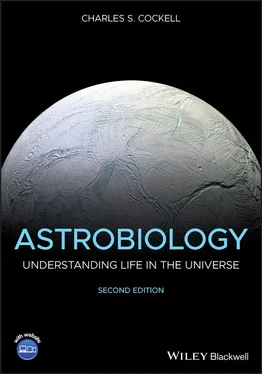1 Cover
2 Acknowledgments
3 About the Companion Website
4 1 Astrobiology 1.1 Introductory Remarks 1.2 The Major Questions of Astrobiology and the Content of the Textbook 1.3 Some Other Features of the Textbook 1.4 A Brief History of Astrobiology 1.5 Conclusions Bibliography
5 2 What Is Life? 2.1 The Concept of “Life” 2.2 What Is Life? The Historical Perspective 2.3 Spontaneous Generation 2.4 More Modern Concepts 2.5 Schrödinger and Life 2.6 Life as a Dissipative Process 2.7 Life: Just a Human Definition? 2.8 Does It Matter Anyway? 2.9 Conclusions Bibliography
6 3 Matter and Life 3.1 Matter and Life 3.2 Life Is Made of “Ordinary” Matter 3.3 The Atomic Nucleus 3.4 Electrons, Atoms, and Ions 3.5 Types of Bonding in Matter 3.6 Ionic Bonding 3.7 Covalent Bonding 3.8 Metallic Bonding 3.9 Van der Waals Interactions 3.10 Hydrogen Bonding 3.11 An Astrobiological Perspective 3.12 The Equation of State Describes the Relationship Between Different Types of Matter 3.13 Other States of Matter 3.14 The Interaction Between Matter and Light 3.15 Conclusions Bibliography
7 4 The Molecular Structure of Life 4.1 Building Life 4.2 The Essential Elements: CHNOPS 4.3 Carbon Is Versatile 4.4 The Chains of Life 4.5 Proteins 4.6 Chirality 4.7 Carbohydrates (Sugars) 4.8 Lipids 4.9 The Nucleic Acids 4.10 The Solvent of Life 4.11 Alternative Chemistries 4.12 The Structure of Life and Habitability 4.13 Conclusions Bibliography
8 5 The Cellular Structure of Life 5.1 From Molecules to Cells 5.2 Types of Cells 5.3 Shapes of Cells 5.4 The Structure of Cells 5.5 The Structure of Cellular Membranes 5.6 The Information Storage System of Life 5.7 Eukaryotic Cells 5.8 The Reproduction of Cells 5.9 Why Did Sexual Reproduction Evolve? 5.10 The Growth of Populations of Cells 5.11 Moving and Communicating 5.12 Viruses 5.13 Prions 5.14 Conclusions Bibliography
9 6 Energy for Life 6.1 Energy and Astrobiology 6.2 Life and Energy 6.3 The Central Role of Adenosine Triphosphate 6.4 Chemiosmosis and Energy Acquisition 6.5 What Types of Electron Donors and Acceptors Can Be Used? 6.6 Aerobic Respiration 6.7 Anaerobic Respiration 6.8 Fermentation 6.9 Chemoautotrophs: Changing the Electron Donor 6.10 Energy from Light: Photosynthesis 6.11 Oxygenic Photosynthesis 6.12 Anoxygenic Photosynthesis 6.13 Rhodopsins and Photosynthesis 6.14 Evolution of Photosynthesis 6.15 Global Biogeochemical Cycles 6.16 Microbial Mats – Energy-Driven Zonation in Life 6.17 The Thermodynamics of Energy Acquisition and Life 6.18 Energy and Life in Extremes 6.19 Conclusions Bibliography
10 7 The Limits of Life 7.1 The Limits of Life 7.2 The Importance of the Limits of Life for Astrobiology 7.3 The Most Extreme Conditions are Dominated by Microbes 7.4 Life at High Temperatures 7.5 Life at Low Temperatures 7.6 Salt-Loving Organisms 7.7 pH Extremes 7.8 Life Under High Pressure 7.9 Tolerance to High Radiation 7.10 Life in Toxic Brews 7.11 Rocks as a Habitat 7.12 Polyextremophiles – Dealing with Multiple Extremes 7.13 Life Underground 7.14 Dormancy in Extreme Conditions 7.15 Eukaryotic Extremophiles 7.16 Are There Other Biospheres with Different Limits? 7.17 The Limits of Life: Habitability Revisited 7.18 Conclusions Bibliography
11 8 The Tree of Life 8.1 A Vast Quantity of Life 8.2 Evolution and a “Tree of Life” 8.3 Classifying Organisms 8.4 The Tree of Life and Some Definitions 8.5 Problems with Classification: Homology and Analogy 8.6 Building a Phylogenetic Tree Using Genetic Material 8.7 Types of Phylogenetic Trees 8.8 A Modern View of the Tree of Life 8.9 Using Phylogenetic Trees to Test Hypotheses 8.10 Complications in Building Trees 8.11 Origin of Eukaryotes 8.12 The Last Universal Common Ancestor 8.13 Multiple Origins of Life? 8.14 Alien Life 8.15 Conclusions Bibliography
12 9 The Universe, the Solar System, and the Elements of Life 9.1 Our Cosmic Situation 9.2 In the Beginning: The Formation of the Universe 9.3 Stellar Evolution: Low-Mass Stars 9.4 Stellar Evolution: High-Mass Stars 9.5 The Elements of Life 9.6 The Hertzsprung–Russell Diagram 9.7 The Sun Is a Blackbody 9.8 The Formation of Planets 9.9 Types of Objects in Our Solar System 9.10 Meteorites and Their Classification 9.11 Laws Governing the Motion of Planetary Bodies 9.12 Conclusions Bibliography
13 10 Astrochemistry: Carbon in Space 10.1 Astrochemistry: Carbon Molecules in Space 10.2 Observing Organics 10.3 In the Beginning 10.4 Different Environments for Chemistry 10.5 How Do Chemical Reactions Occur? 10.6 Forming Carbon Compounds 10.7 Formation of Water 10.8 Interstellar Grains 10.9 Polycyclic Aromatic Hydrocarbons 10.10 Even More Carbon Diversity 10.11 Comets and Organic Molecules 10.12 The Origin of Chirality 10.13 Laboratory Experiments 10.14 Observing Organic Molecules 10.15 Conclusions Bibliography
14 11 Early Earth: The First Billion Years 11.1 The First Billion Years of Earth 11.2 Earth Forms and Differentiates 11.3 The Formation of the Moon 11.4 The Early Oceans 11.5 The Early Crust 11.6 The Early Atmosphere 11.7 The Temperature of Early Earth 11.8 The Late Heavy Bombardment 11.9 Implications of the Early Environment for Life 11.10 Conclusions Bibliography
15 12 The Origin of Life 12.1 The Origin of Life 12.2 The Synthesis of Organic Compounds on Earth 12.3 Delivery from the Extraterrestrial Environment 12.4 The RNA World 12.5 Early Cells 12.6 Where Did the Origin of Life Occur? 12.7 A Cold Origin of Life? 12.8 The Whole Earth as a Reactor? 12.9 Conclusions Bibliography
16 13 Early Life on Earth 13.1 Early Life on Earth 13.2 Early Life – Metabolisms and Possibilities 13.3 Isotopic Fractionation 13.4 Measuring the Isotope Fractionation: The Delta Notation 13.5 Sulfur Isotope Fractionation 13.6 Using Isotopes to Look for Ancient Life 13.7 Morphological Evidence for Life 13.8 Biomarkers 13.9 Contamination Is a Problem 13.10 Instruments Used to Look for Life 13.11 A Brief Summary 13.12 The Search for Extraterrestrial Life 13.13 Conclusions Bibliography
17 14 The Geology of a Habitable World 14.1 The Geological History of Earth: A Habitable World 14.2 Minerals and Glasses 14.3 Types of Rocks 14.4 The Rock Cycle 14.5 The Composition of Earth 14.6 Plate Tectonics 14.7 Dating the Age of the Earth (and Other Planetary Bodies) 14.8 Age-Dating Rocks 14.9 Geological Timescales 14.10 The Major Classifications of Geological Time 14.11 Some Geological Times and Biological Changes 14.12 Conclusions Bibliography
18 15 The Co-evolution of Life and a Planet: The Rise of Oxygen 15.1 Dramatic Changes on Earth 15.2 Measuring Oxygen Through Time 15.3 It Was Not a Simple Rise 15.4 Summarizing the Evidence for the GOE 15.5 The Source of Oxygen 15.6 Sinks for Oxygen 15.7 Why Did Atmospheric Oxygen Concentrations Rise? 15.8 Snowball Earth Episodes 15.9 Other Biological Consequences of the Rise of Oxygen 15.10 Oxygen and the Rise of Animals 15.11 Oxygen and the Rise of Intelligence 15.12 Periods of High Oxygen 15.13 Conclusions Bibliography
19 16 Mass Extinctions 16.1 Extinctions 16.2 What Is Extinction? 16.3 Five Major Mass Extinctions 16.4 Other Extinctions in Earth History 16.5 Causes of Mass Extinction 16.6 The End-Cretaceous Extinction 16.7 The Other Four Big Extinctions of the Phanerozoic 16.8 Do Microorganisms Go Extinct? 16.9 Recovery from Extinction 16.10 Can We Avoid Extinction? 16.11 The Sixth Mass Extinction? 16.12 Conclusions Bibliography
20 17 The Habitability of Planetary Bodies 17.1 What Is “Habitability”? 17.2 The Habitable Zone 17.3 Maintaining Temperature Conditions on a Planet Suitable for Water and Life 17.4 Plate Tectonics and Habitability 17.5 Does the Moon Play a Role in Habitability? 17.6 Other Planetary Factors that Influence Habitability 17.7 Surface Liquid Water, Habitability, and Intelligence 17.8 Habitable Environments Need Not Always Contain Life 17.9 Worlds More Habitable than Earth? 17.10 The Anthropic Principle and Habitability 17.11 The Fate of Earth 17.12 The Galactic Habitable Zone 17.13 The Right Galaxy? 17.14 Conclusions Bibliography
Читать дальше












